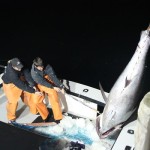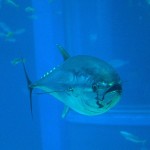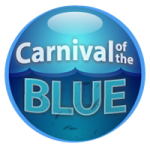
When I wrote about Wicked Tuna, the National Geographic channel’s Atlantic bluefin tuna fishing reality show (first aired Sunday night), I thought it would be pretty straightforward. Every rating system – Seafood Watch, Sea Choice, Blue Ocean Institute – lists Atlantic bluefin as an “Avoid.” A look through the scientific literature – though I am not a tuna or fisheries expert – showed a vast gap between the fisheries literature, which focuses on bluefin population structure , and the conservation literature, which is trying to sound the alarm about bluefin’s decline. Frankly, I didn’t think it would be terribly controversial to argue that a purportedly conservation-focused organization like National Geographic shouldn’t encourage consumption of Atlantic bluefin tuna.
So I was pretty surprised when two very different scientists, Lee Crockett, Director of Federal Fisheries Policy at the Pew Environment Group and Dr. Molly Lutcavage, Director of the Large Pelagics Research Center at U Mass-Amherst disagreed with my perspective. (I was offered a chance to talk with Crockett about bluefin before the post went up, but the scheduling didn’t work out until afterwards. Dr. Lutcavage reached out to DSN in response to the post.) Both of these tuna experts believe that Wicked Tuna is good publicity for the Atlantic bluefin.
Crockett sees Wicked Tuna as an opportunity to educate the public as to what fisheries should look like. He said, “Most people have no clue where their fish come from. This show gives a sense of what fishing is actually like. Pew is supportive of small scale selective fishermen – they’re the kind of fishermen we ought to be supporting since they are selective and catch what they target. Unless you are opposed to all fishing, these are the kind of fisheries we ought to be promoting.”
I asked him if the show was misleading, since most Americans are not eating tuna caught with hand gear – the most popular seafoods in America are farmed shrimp, farmed salmon, and canned tuna (which is mostly caught with far less selective longlining or purse seining). He pointed out that bluefin is indeed a niche market in the United States, but “I look at it the same way National Geographic looks at it – the show is educating people in an entertaining way about bluefin and different types of fishing. They’re educating the public and getting them to understand where their food comes from.” While Americans aren’t eating significant amounts of tuna caught with hand gear, “the show itself is an opportunity to educate them about fishing, types of fishing and general principles that are useful.” Since Pew’s bluefin tuna conservation efforts focus on reducing longline bycatch of spawning adults and other marine wildlife in the Gulf of Mexico, increasing the public understanding of fishing gear is critical to their work.
Dr. Lutcavage had a much more basic disagreement – she says there are far more bluefin tuna in the Atlantic than have been reported in the stock assessments. She said, “We lack some of the most basic knowledge on life history and population status. We don’t know how they [the tuna] utilize the oceans.” In order to see as many commercially sized bluefin as we do, Lutcavage said, “the numbers of juveniles must be huge.” She noted that in 1993, the bluefin tuna stock assessment indicated that there were only 7000 adults left, but that aerial surveys “counted a couple hundred thousand in a small area.” According to Lutcavage, “No one ever made corrections.”
Lutcavage, who was interviewed for Wicked Tuna‘s website, was frustrated with the way that scientific uncertainty is communicated in fisheries management. “The story represented in the media is not good science and doesn’t represent what the state of the art is…stuff people are touting is wrong. No one does cleanup in the media.” Scientists “need to look back and see how we did…getting it right is important and not getting it right has impacts.”
I asked both Crockett and Lutcavage if people should eat Atlantic bluefin tuna. Both stressed that overfishing is occurring in the eastern Atlantic and Mediterranean, and that the western Atlantic was relatively well managed. Crockett encouraged people to learn more about fisheries. “Wicked Tuna is useful because it is raising people’s awareness in a way that is entertaining. And then you throw in a conservation message, there’s a greater chance of it resonating and sticking with them a little bit. People see the PSAs that go along with it [Wicked Tuna], they click on a website, and learn some more.” Lutcavage stressed that what you eat is a personal choice, but that she herself “would not eat a fish caught in the Mediterranean until they are complying with [ICCAT] quotas. I support our local fisheries fishing responsibly and sustainably.”
So will Wicked Tuna really educate people about the advantages of hand gear is over purse seining or longlining, and about regulatory uncertainty in fisheries management? I haven’t seen the show yet, so I can’t say. I can say this – these conversations threw me into a bit of a fisheries existential crisis. If a marine scientist such as myself can’t read through the peer-reviewed scientific literature and ICCAT stock assessments and form a reasonable opinion on whether eating Atlantic bluefin tuna is Good or Bad, what hope does the general public have? I imagined trying to explain the complexities of the Wicked Tuna fishery to my sushi-loving non-scientist sister who lives north of Boston, not far from Gloucester.
Me: “Hey, did you know that you can eat bluefin tuna caught in Gloucester? There’s a TV show!”
Sister: “Cool! How do you know if the tuna comes from Gloucester?”
Me: “Well, ask the server.”
Sister: “You want me to give a fish quiz to the server? What if they don’t know? Or don’t speak good English?”
Me: “Ask them to ask the chef.”
Sister: “Ummm…ok.”
Me: “But be careful because a lot of bluefin that’s sold is ranched and that’s bad.”
Sister: “Ranched?”
Me: “Unless the fish is mislabeled. So actually it may not be bluefin tuna at all.”
Sister: “You know, I like eel too.”
Me: “But eel is bad!”
Sister: “So, how about those Red Sox?”
Me: “What? Since when do we talk about baseball?”
Sister: “But it’s better than listening to THIS.”
Over the past years I’ve had many of these encounters. While seafood-choice style cards work for the informed consumer purchasing their fish from fishmongers or higher-end restaurants, they’re pretty challenging to use in a more general market. My family, all of whom are dedicated chain supermarket fish counter customers, call me from the fish counter on occasion to ask if something is “good” or “bad.” It’s astonishingly difficult to figure out – just last week my father told me proudly that he purchased steelhead and wasn’t that a good choice? I did a double take. Steelhead? Federally-listed-as-threatened steelhead? At the supermarket? But then I realized it was probably just regular farmed rainbow trout, marketed under a fancier-sounding name. Even an informed consumer is dependent upon correct labeling and provenance – and seafood mislabeling is rampant. I’ve even been outright lied to in restaurants by servers who just don’t want to deal with a Portlandia-style inquisition.
Maybe the biggest value of the controversy over Wicked Tuna will be the spotlight that it shines on the complexity of sustainable fisheries. As Crockett said in our conversation, “The hardest thing we have is getting people to listen. Wicked Tuna may be an entry point to get people to pay attention.”
BEFORE COMMENTING READ THIS: Critical comments are welcome, but comments containing personal insults will be deleted without warning.
Share the post "Eating Wicked Tuna: A marine scientist tries to figure out what the heck is going on"






I hear you — I use http://www.sustainablesushi.net for this stuff — good luck
I was reminded of this article about Whole Foods, http://www.npr.org/templates/story/story.php?storyId=149665074 :
“Starting Earth Day, April 22, the natural and organic supermarket chain will no longer carry wild-caught seafood that is “red-rated,” a color code that indicates it is either overfished or caught in a way that harms other species. The ratings are determined by the Blue Ocean Institute, an advocacy group, and the Monterey Bay Aquarium in California.
Among the seafood disappearing from Whole Foods shelves will be octopus, gray sole, skate, Atlantic halibut and Atlantic cod caught by trawls, which can destroy habitats. The company will stock sustainable replacements like cod caught on lines and halibut from the Pacific.”
I don’t know much about a lot of things, but I do the food shopping for my family. I think it’s great that Wicked Tuna is getting people to talk about the issue. The more people know to ask if it is Atlantic Bluefin Tuna, then one would hope the response will be the information will become readily available to the consumer. And as a result, local shops/resteraunts will be more likely to supply local products as the demand goes up, and not foreign products as the demand goes down.
There seems to be a lot more awareness and education, at least in eastern MA, about where all of our food comes from. With any luck, more people will start to make more choices that are healthier both for our bodies and for our environment.
Thanks again for taking this issue “to the streets” as it were great responses.
good postings. If anyone wants more info on bluefin tuna: I’m the founder of Blue Ocean Institute which has been working with Whole Foods on seafood sustainability. I used to fish for bluefin tuna but I’ve been involved specifically in bluefin tuna conservation since 1990, including assessments of whether they qualify as endangered.
I’ve written several pieces about Nat Geo’s Wicked Tuna on Huffington Post and there’s more on my blog at carlsafina.org in the bluefin tuna folder.
I’ve written several scientific articles about bluefin tuna as well; see for example:”Collapse of Bluefin Tuna in the West Atlantic”
http://onlinelibrary.wiley.com/doi/10.1111/j.1523-1739.2008.00901.x/abstract
Hello all. I am not getting into one side or the other since there are so many sides. However it is good that conversations take place, positions put on the table and let the negotiations begin. If we can take one step at a time and get something useable by many we will be successful and the stock survives.
I have not seen the show, so I will only comment on the commentaries I have read. It is really quite simple — there are two issues people should be aware of — what fishery are we talking about, and what gear type are we talking about. Bluefin tuna in the Mediterranean and Eastern Atlantic is in bad shape whether it is caught by net, longline, or harpoon. It is in bad shape because the “holier then thou” countries of the EU can’t obey the rules they agree to in International Convention for the Conservation of Atlantic Tuna. The US, which makes sure its fishermen follow the internationally agreed to rules, for a change is not the bad guy.
Most environmental groups paint the picture with too broad a brush — don’t eat bluefin tuna — it is in bad shape. No distinction is made between bluefin caught in the western Atlantic by US fishermen or that from fattening farms in Mexico from that caught in violation of ICCAT rules. Same with the old “give swordfish a break” campaign — yes, Atlantic swordfish was in trouble for a while — but Pacific swordfish was quite healthy. Unfortunately, without the distinction, many US Pacific swordfish fishermen went broke. So one needs to know the fishery, and to an extent how it is fished and by whom.
US swordfish fishermen have been heavily regulated, so much so, that on the East coast they have not been able for the last several years to take as many fish as they are permitted to under ICCAT rules. So other countries want that “surplus” quota. Does the US reward US fishermen for following the rules and helping bring back the stock — no, it uses the “excess” swordfish quota to bargain with the EU countries so they won’t fish eastern Atlantic Bluefin tuna to extinction.
Gear type is another, separate concern. Many groups are against coal fired power plants that emit mercury — great — we all think there should be less mercury in the air. But when they can’t get any traction with the general public on clean air, they turn to tuna, and start sending out all kinds of inaccurate and just plain wrong information on mercury in tuna and swordfish. They ignore scientific studies which have show the mercury content in fish is not as important as the selenium content, which is high and which binds with mercury so it is harmless. So too, they go after tuna caught by longline vessels because of the interaction with sea turtles and sea birds. Again they ignore the improvements in fishing techniques and equipment which have solved the seabird and turtle interactions which were a problem years ago. They also ignore the fact that sea turtles are most affected by their eggs being destroyed in other countries and their nesting grounds being devastated in other countries by beach resort development. Instead they demonize what is in every US households supply closet — canned tuna.
The same with farmed fish — years ago there were many problems with the way salmon was farmed — pollution, disease, escaping salmon which would out-forage wild salmon and thereby reduce their numbers. Some of these problems have been solved, and some have not.
The point is, you can ask your server where the fish is from and how it was caught, and what country’s fishermen caught it. He can ask the chef. If the chef doesn’t know, he can ask his purveyor. It is not that hard and it is not that confusing or difficult if you really care. And US consumers should care — fish consumption in the US has been increasing while the percentage of fish which is supplied by American fishermen has dwindled to less than 15%. Where does the 85% of the fish come from that we consume — generally from countries that care less about pollution, disease, sea turtles, sea birds, marine mammals, and playing by the rules than US fishermen do. If “Wicked Tuna” can get some of these distinctions out on the table — all the better!!!
Thank you for writing about this issue. Please note that almost 40,000 people in 99 countries have pledged not to consume bluefin tuna – Southern, Pacific, and Atlantic bluefin tuna, regardless of gear type. This is because harvests are unsustainable and put these fish in peril of being wiped out. The pledge is at http://www.bluefinboycott.org.
The Center for Biological Diversity disagrees that U.S. management of western Atlantic bluefin tuna is adequate. Details about the Center’s litigation over this year’s expansion of the commercial bluefin tuna fishery – despite declining quotas and fewer available bluefin tuna – is linked here: http://www.biologicaldiversity.org/species/fish/Atlantic_bluefin_tuna/index.html
The Center’s press release about Wicked Tuna is here: http://www.biologicaldiversity.org/news/press_releases/2012/bluefin-tuna-03-30-2012.html
I LOVE Portlandia! That said, I am sending a link to all my email list, hoping to bring overfishing to their attention. I taught a section on sustainable fisheries to my introductory ecology class way back, and have been trying to follow research ever since.
We need to get this information out there.
I love the conversation between you and your sister, as well as the Portlandia reference. After reading your article I realized maybe seafood restaurants could up their status (stars?) by having well educated servers. I guess that is already the case, though. Here is something interesting about MD crab labeling. http://www.hometownannapolis.com/news/ENV/2012/04/06-26/True-blue-program-to-promote-local-crabs.html Great post!
Nice post Miriam! As the saying goes, nothing is easy.
In New Zealand, there is increasing concern that once species like tuna are depleted far enough to be unviable as a commercial catch, there will be an even greater push to fish species living in deeper water or Antarctic species that haven’t yet been targetted.
Unfortunately, one should be dubious of anything produced by National Geographic in the past decade. It is primarily owned by Fox Cable Networks, a division of Rupert Murdoch’s News Corporation, where an individual’s right to turn a profit by any means they see fit takes far more precedence over those pesky environmentalists and their agenda to ruin everybody’s ‘fun’. :P